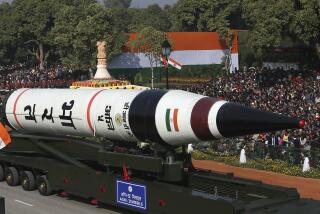Silkworm Missile Is Chinese Copy of 28-Year-Old Soviet Styx
- Share via
The Silkworm missile is a Chinese copy of a Soviet surface-to-surface missile known as the SS-N-2, or Styx, primarily used as a shipborne offensive weapon or as part of a coastal defense system. The land-based version that Iran has is easily transportable aboard trucks and could be hard to find in a retaliatory raid, military analysts said Friday.
The missile, first built in 1959, is not highly accurate, and Pentagon officials said that the direct hit on the Sea Isle City may have been as much luck as successful targeting. The missile’s radar guidance operates only during the final phase of its flight, officials said.
The Chinese have carried the weapon on their warships and employed the land-based version for 20 years but have made them available for export only since 1984, according to the authoritative Jane’s Defense Weekly.
The Chinese call the missile the Hai Ying (Sea Eagle) and manufacture it in Beijing. China has sold the weapon to several nations in Africa and the Middle East, including Iraq. Chinese officials have repeatedly denied selling the weapons to Iran.
Iran claims to have seized the weapons from Iraq when Iran captured the Faw Peninsula, at the northern end of the Persian Gulf, in February, 1986. Military analysts estimate that Iran has about 200 of the missiles.
U.S. military officials discovered the Silkworms deployed at the Strait of Hormuz this spring and warned Iran not to use them against shipping. Last month, in their first known use, the Iranians fired two or three Silkworms from the Faw Peninsula toward neighboring Kuwait. One landed and exploded near the coast south of Kuwait City; one or two missiles fell into the sea not far from where the Sea Isle City was hit Friday.
The missile has a range of about 50 miles, which puts the Kuwaiti anchorage just within range of Silkworm batteries on the Faw Peninsula. The range also allows Iran to cover the entire Strait of Hormuz from emplacements at Bandar Abbas and Kuhestak on Iran’s southern coast.
The low-flying missile usually carries a 250-pound warhead and is launched from a trailer towed behind a radar-guidance truck. Roughly 15 feet in length and 3 feet in diameter, the Silkworm climbs to an altitude of 145 yards before dropping to an approach altitude of 30 yards.
More to Read
Sign up for Essential California
The most important California stories and recommendations in your inbox every morning.
You may occasionally receive promotional content from the Los Angeles Times.












